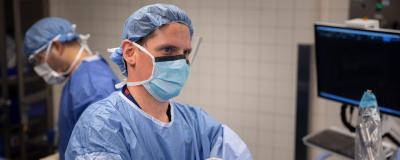Tibial tubercle osteotomy (TTO) is an important surgical procedure aimed at correcting patellofemoral malalignment and treating symptomatic conditions such as patellar instability and patellofemoral cartilage damage. Anteromedialization of the tibial tubercle with the Fulkerson osteotomy is widely implemented for its effectiveness in optimizing patellar tracking and reducing patellofemoral contact pressures.
Intraoperative adjustment
Despite its clinical success, one of the enduring challenges in TTO is ensuring that the surgical adjustments intended by the surgeon during the operation are accurately translated into the anatomical changes observed in postoperative outcomes. This discrepancy between planned and actual outcomes necessitates rigorous assessment to enhance surgical precision and patient outcomes.
“When we measure the angle of the TTO using a standard guide, it doesn’t take into account individual differences in each patient’s pathoanatomy,” explains Adam Yanke, MD, PhD. “Therefore, our pre- and postoperative measurements can vary. We want to try to minimize this difference through patient-specific instrumentation.”
The choice of osteotomy angle and the degree of tubercle translation are tailored according to the specific pathology being addressed. For patellar instability, the procedure aims to medialize the extensor mechanism, shifting the tibial tubercle medially and slightly anteriorly to stabilize the patella within the trochlear groove during knee flexion, thus improving patellar tracking.
In contrast, cases involving patellofemoral pain or degenerative arthritis often require more pronounced anteriorization. This modification aims to reduce and redistribute the patellofemoral joint forces away from the deteriorated distal and lateral quadrants of the patella to the healthier proximal and medial quadrants, thereby alleviating pain and decelerating the progression of joint degeneration.
Continued measurement
This study extends the work of Liu, et al, who used postoperative MRI to validate intraoperative metrics of TTO. We found that MRI measured TTO angles deviate from the planned or charted angles by an average of around 10°, while angle accuracy decreases at shallow and steeper intended angles.
The accuracy of the TTO angle is crucial in Fulkerson osteotomy procedures, as incorrect angles can lead to either under- or overcorrection of patellar tracking, potentially necessitating revision surgery. This study found that flatter osteotomy angles often resulted in higher measured angles than those estimated by surgeons, causing insufficient medialization in patients with lateral patellar instability, while steeper angles were often underestimated, leading to inadequate anteriorization.
Two measurement methods for TTO angles were examined, showing comparable accuracy and reliability. One method, based on proximal tibia anatomy, underestimated charted values, especially on more distal MRI slices. The novel method proposed measured the osteotomy angle relative to the horizontal of the MRI axial slice. This mirrors intraoperative measurement and emphasizes the importance of standardized foot positioning in both imaging and surgery to ensure accurate assessment and successful outcomes.

Improved accuracy with a 3D-printed guide
Additionally, we were able to successfully develop a patient-specific, 3D-printed TTO guide that has the potential to be utilized in future surgeries. Using a cadaveric model, we are testing our ability to print guides that exactly match osseous anatomy and facilitate translation of the tubercle in a simulated surgery.
“To our knowledge, we’re the first institution to begin developing patient-specific guides for this specific osteotomy. The TTO is a unique procedure because it is one of the few osteotomies we perform that doesn’t have information on who is truly indicated. These guides will improve upon what is already a highly successful procedure,” Dr. Yanke says.
The translation component of the 3D guide can be used to precisely anteriorize, medialize or distalize the tibial tubercle according to preoperative measurements. Most importantly, it can be utilized for cutting planes that are not commonly seen in commercially available guides.
Further study is required on these guides before they can be used in the clinical setting. This includes rigorous testing on a variety of pathoanatomy at a variety of osteotomy angles and translations to ensure its effectiveness in a variable patient population.
Overall, we believe the patient-specific guide is economically viable and can be customized to fit the exact needs of the individual.



